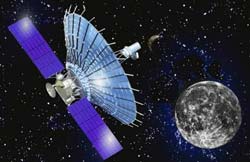2007: Russia enters a space of life research labs outside of Earth
The study of extraterrestrial life will be the main mission of the Russian astrophysics laboratory Radioastron. According to Professor Nikolai Kardachev at the Astronomical Center of the Lebedev Institute of Physics, this space lab will be launched in 2007 from Baikonur space airport.

Radioastron space lab model
Radioastron astrophysics laboratory is equipped with powerful scientific equipment and a parabolic antenna with a diameter of 12m will be put into orbit by a Ukrainian rocket launcher Zenith. Russia has spent about 3 million rubles to create this lab.
'This is a radio interferometer - the equivalent of a radio telescope - that will move at a height of 350,000 kilometers from Earth,' Professor Kardachev explained.
The very eccentric orbits of Radioastron will allow continuous monitoring and study of plasma body details (the gas has the same number of positive and negative charged particles on the Sun and most of the stars) of the solar wind. , galactic nuclei, interstellar environments orbiting black holes, as well as quasars (the source of a very strong magnetic image). These bodies are so far away from the Earth that they cannot understand their structure with current devices.
- Planets Labs raises funds to launch a satellite squadron to planet Earth next year
- Russia and the US still cooperate in space research
- The US plans to continue the ISS program with Russia after 2020
- Research reproduces the process of forming life in the universe
- Russia spends $ 2 billion
- Russia declared war on meteors threatening the Earth
- Thien Cung 2 space station re-enters the atmosphere, being 'controlledly destroyed'
- Follow the rocket to outer space and return to Earth
- Russia will build bases on the moon?
- Tomorrow Russia's uncontrolled spacecraft will fall to Earth
- Russia plans to shorten the operational duration of the ISS station
- Find the 'Second Earth' that contains life?
 Van Allen's belt and evidence that the Apollo 11 mission to the Moon was myth
Van Allen's belt and evidence that the Apollo 11 mission to the Moon was myth The levels of civilization in the universe (Kardashev scale)
The levels of civilization in the universe (Kardashev scale) Today Mars, the sun and the Earth are aligned
Today Mars, the sun and the Earth are aligned The Amazon owner announced a secret plan to build a space base for thousands of people
The Amazon owner announced a secret plan to build a space base for thousands of people